You’ve probably seen Aaron Franklin smoke a brisket, but how does he smoke a pork butt for pulled pork? Texas isn’t known for smoked pork, and Franklin admits he doesn’t cook it very often. But when he makes pulled pork, this is how he does it.
When making pulled pork, Aaron Franklin cooks pork butt at 275° F. He leaves at any smoker for the first 5 hours untouched, then spritzers and wraps. He removes the pork after about 8 hours, then rests for 30 minutes before shredding. Prior to cooking, Franklin applies a Texas style rub which 50/50 salt and pepper, with a little of paprika onion powder and garlic powder.
Franklin Pork Butt
| Component | Description |
|---|---|
| Temperature | 275°F in an offset smoker |
| Cook Time | 8 hours |
| Rub | 50/50 mix of coarse black pepper and kosher salt, sometimes with paprika, onion powder, and garlic powder |
| Binder | Olive oil |
| Trimming | Removing glands and blood clots, leaving some fat on, peeling off rind if attached |
Quick Tips
- Aaron Franklin smokes pork butt at 275°F using an offset smoker
- He maintains this temperature throughout the entire cook, which takes about 8 hours
- He applies a Texas-style rub, which is a 50/50 mix of coarse black pepper and kosher salt, and sometimes adds a little paprika for color
- He also uses onion powder and garlic powder in his rub
- He applies olive oil as a binder to help the rub stick to the meat
- He trims the pork butt by removing any glands or blood clots, but leaves some of the fat on for added flavor
- He also peels off the rind if the pork shoulder or pork butt comes with it attached, as it will stop smoke from penetrating the meat
- He does not use any binder for the pork butt.
Aaron Franklin Style Pulled Pork (Pork Butt)
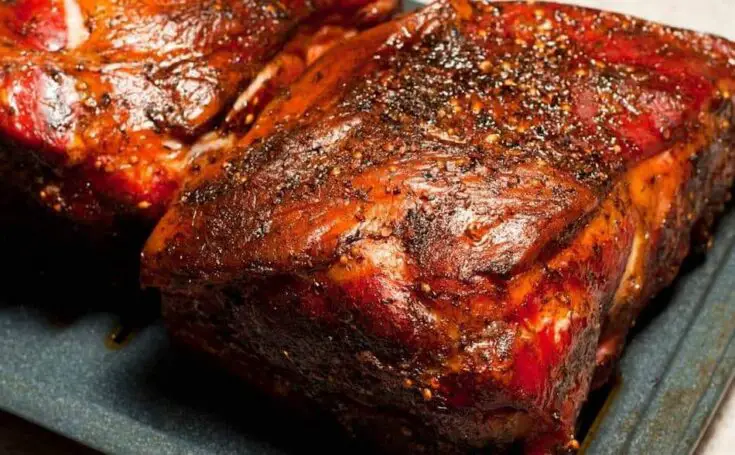
Pulled pork made from pork butt cooked low-and-slow on a smoker.
Ingredients
- 1 pork butt (bone in)
- Coarse black pepper.
- Morton’s Kosher Salt.
- Paprika
- Granulated onion
- Garlic powder
- Olive oil
Instructions
- Trim any large chunks of fat off the pork.
- Combine the rub. Franklin uses a 50/50 mix of cafe-grind black pepper and kosher salt. If you want some color, add a small amount of paprika. For some savory tones, add some granulated onion, and garlic powder.
- Put the rub in a shaker.
- Using olive oil, apply a binder to the meat so the rub sticks. Apply a generous amount of the rub so it’s completely covered.
- Set the temperature of your smoker to 275° F.
- Throw on some smoking wood. Hickory blends well with pork. If you want a softer smoke, use apple or cherry.
- Leave the pork in the smoker for 5 hours.
- Assess the bark. Once the bark has cracked, it’s time to wrap.
- Wrap the pork in two layers of thick aluminium foil.
- Before you close the foil, spritz with apple cider vinegar.
- Place back into the smoker at 275°F for another 3 hours.
- At about the 8-hour mark, check the pork. It should be close to done.
- Perform a tenderness test. If you can pull the bone out of the pork, that’s a sign the meat is tender and ready to be shredded.
- Rest the pork for 30 to 45 minutes to allow the meat to reabsorb the juices.
- Shred the meat for pulled pork.
Nutrition Information:
Serving Size:
100 gramsAmount Per Serving: Calories: 168
What Temperature Does Aaron Franklin Smoke Pork Butt?
Aaron smokes pork butt at 275°F using an offset smoker. He maintains this temperature throughout the entire cook. You can cook the pork anywhere between 225°F and 275°F. The only difference will be the total cook time. Franklin’s go-to temp of 275° F is a little hotter than most people cook. The standard low-and-slow range is usually about 225° F. Once you go over 275° F, it will put the meat at a risk of drying out—so be careful. Obviously, the meat will cook faster if you cook at 275°F.
What Rub Does Aaron Franklin Use On Pork Butt?
If you’ve watched Aaron Franklin smoke meat, you would know he almost always uses a Texas-style rub. A Texan rub is simply a 50/50 mix of coarse black pepper and kosher salt. Franklin will sometimes add a little paprika for color. When putting together his rub, Franklin uses a 16-mesh coarse cafe grind black pepper, with Mortons kosher salt. He uses a 50/50 ratio (half salt, half pepper). With pork, Aaron adds a little of paprika for color. Pork shoulder is a large cut of meat, and Aaron believes it can take a lot of salt.
For his pork butt recipe, Franklin also uses onion powder, which is a common ingredient in barbecue rubs. He uses granulated onion sometimes to add to the texture of the bark, and to give the meat a savory flavor. Franklin usually mixes his rub in a plastic container, then puts the rub into a shaker. He then spreads the rub evenly by distribution.
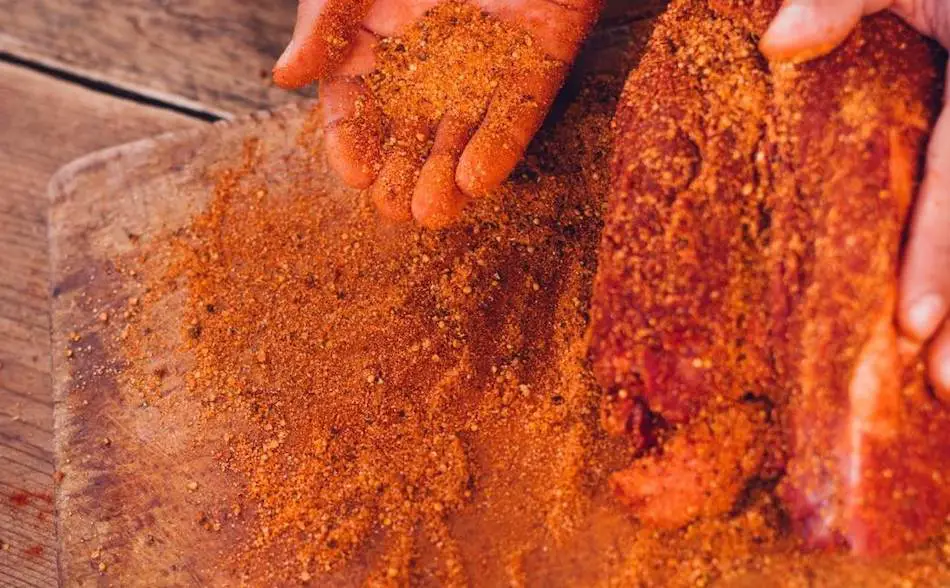
Trimming Pork Butt
With pork butt, the fat is usually on one side of the meat. On the other underside, you might get a few glands and a few blood clots etc. Make sure you take those off because they will not render (cook down). Aaron will leave a lot of the fat on because he believes pork butt is a little of a bland, so he’ll cook down the fat to give it a bit more flavor and moisture. If the pork shoulder or pork butt comes with the rind attached, peel that off because that’s going to stop smoke from penetrating the meat. You can do your pork crackling as a separate side dish.
Does Aaron Franklin Use A Binder For Pork Butt?
To help the rub stick, Franklin uses olive oil as a binder. When the pork is cooked, you won’t be able to taste the binder. Some people use yellow mustard as a binder. The bark is one of the best features of pulled pork. The rub plays an important role in bark formation. If you don’t use a binder, the bark may become patchy. Therefore, you want to make sure the rub sticks. Applying olive oil or mustard will help the rub bind to the meat, forming a bar. Aaron also believes the olive oil will help give the pork some color as well.
The Texas Rub
Franklin’s pork butt will look a much darker than most other pork butts on YouTube. Texans like black pepper. So Aaron puts a lot of black pepper on his meat—which is normal for a Texas-style rub. If you’re not a fan of black pepper, you can use, or make a standard barbecue rub on your pork butt. Check out this article for more information on other rubs. There are also several great products on the market, such as Killer Hogs or Slap Yo Daddy. However, if you want to do exactly as Aaron Franklin does, then just stick to the Texas style rub.
The Rub Plays An Important Role In Bark Formation
We all love a nice chunk of bark in our pulled pork. The bark — the crispy outer layer of the meat—give us those nice crunchy bits of meat mixed in between the tender juicy bits. The bark is a combination of dehydrated meat, smoke, and the seasoning (the rub). Smoking meat low-and-slow is all about developing layers of flavor. Most of the flavor layers are built on the outer layer of the meat. Watching Franklin nurture the bark is like watching an artist at work. Pitmasters like Aaron Franklin spend hours nurturing and developing layers and layers of flavor on the outside of the meat.
Does Franklin Smoke Meat Fat-Side-Up Or Fat-Side-Down?
When smoking pork butt, Aaron Franklin cooks fat-side-up. However, Franklin uses an offset smoker—which differs greatly from most smokers. With an offset, there’s a separate fire box which provides indirect heat coming from the side. If you’re using a smoker with a heat source is coming below, I would recommend that you cook fat-side-down. The fat will insulate the meat and help prevent the meat from drying out.
Aaron also suggests flipping the meat at some point in the cook. If you do his, you will get a more even cook. Check the meat a few hours into the cook, and if it’s not getting enough color on a one side—flip it.
Go By “Look And Feel”
When smoking meat, Franklin seems to go more by “look and feel” than anything. He doesn’t use exact cook times or follow strict recipes. And he rarely uses thermometers, so he doesn’t cook to specific internal meat temperatures. But it takes a while to develop those instincts.
Many of us cook to exact internal temperatures—and there’s nothing wrong with that. It’s good to have some guidance when you’re learning. The number most popular in the barbecue community would have to be 203°F (for brisket and pork butt).
Many of us also like to wrap at a specific temperature, or have a set spritzing regime. Times, temperatures, recipes and thermometers are good practices, but at some point, train yourself to go by more by “look and feel” rather than set times or temps. This will come with experience.
When Does Aaron Franklin Wrap Pork Butt?
Franklin wraps pork butt somewhere between 4 and 5 hours. He will begin assessing the bark after about 4 hours. Once the bark has a nice color and the bark splits open, then it’s time to wrap the pork in butcher paper.
Does Franklin Use A Water Pan?
Aaron Franklin always uses a water pan when smoking meat. He believes the water pan helps with the bark. Fill the pan before cooking, and refill with hot water during the cook. You can also place the water pan to catch the fat drippings.
The First 5 hours Of The Cook
Franklin does nothing to the pork butt for the first 5 hours of the cook. He doesn’t spritz, he just leaves it alone. Aaron wants a brisket-like bark on the pork butt. After about 5 hours, the bark should be nice and crunchy.
What Does Aaron Use To Spritz Pork Butt?
Franklin spritzes with apple cider vinegar. However, he says you can also use apple juice, hot water with hot sauce.
When Does Aaron Franklin Spritz?
Unlike a lot of pitmasters, Aaron Franklin doesn’t spritz intermittently. Franklin leaves the pork butt alone for the first 5 hours. He will only spritz just before wrapping. Spritzing too early can lead to a patchy bark. The liquid can cause the rub to wash off the meat, leaving gaps in your bark.
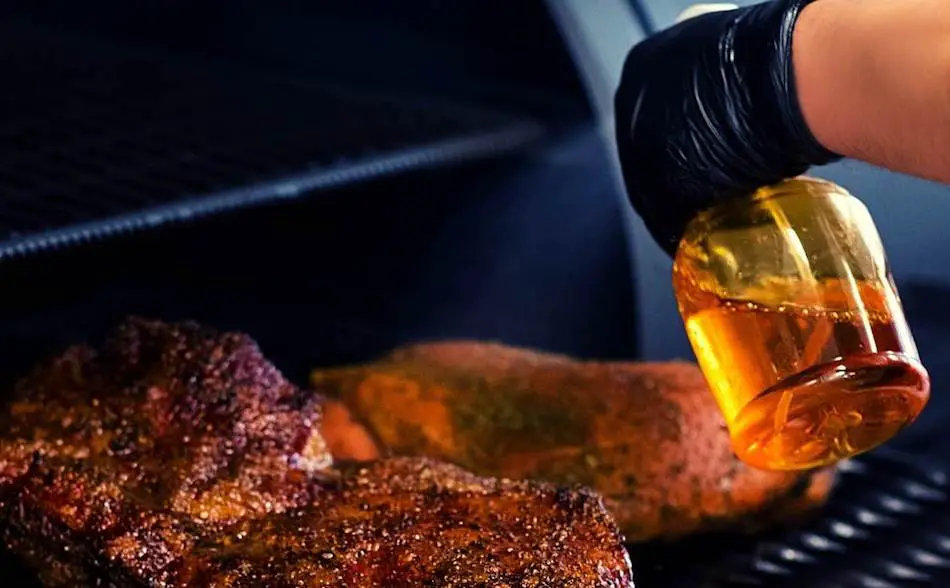
Before Aaron Wraps Pork Butt
After 5 hours, Aaron checks his pork butt. Franklin’s pork butt looks darker than usual because of the peppery Texas-style rub. Before deciding to wrap, Aaron likes to see cracks forming on the bark. A cracking bark is a sign to wrap. Aaron also gives the pork a little squeeze and looks for juice to flow out. Another sign to wrap.
Handle Pork Like Franklin
Whenever Franklin has to pick up the meat, he is extra careful. Rather than using grilling tools, Franklin uses a paper towel or a cloth t transfer the meat to and from the smoker. Franklin warns tongs can rip off big chunks of bark if you’re not careful. You spend so much time preserving and developing the bark, the last thing you want to do is rip it off.
How Aaron Franklin Wraps Pork
When Aaron Franklin wraps the pork butt, he lays out two big layers of aluminium foil. He uses two layers because he doesn’t want the foil to break open. A hole in the foil will cause some of the liquid to run out, and it will slow down the cook by leaving a vent.
When wrapping, use heavy duty aluminium foil. Cheap foil will rip easily. You want to protect all those meat juices, so it’s important to hold it all in because it’s where all the flavor is held. You can also use butcher paper to wrap pork. Some people find the bark turns out better with paper.
The Final Spritz
Before wrapping, Franklin saturates the pork butt with a spritz of apple cider vinegar. He likes to get a pretty wet before closing the wrap.
When Is Pork Butt Done?
Most people cook pork butt to an internal temperature of 200°F. Aaron Franklin doesn’t cook to internal temperature, he cooks to tenderness. Whenever I’ve seen Aaron smoke a pork butt, I’ve never seen him even use a thermometer. To do this, takes many years to master.
The Final Stage Of The Cook
Once Franklin has spritzed and wrapped his pork butt, he tightly wraps it in foil and puts it back on the grill. He maintains a 275°F temperature, and puts it back on the smoker, shuts the lid.
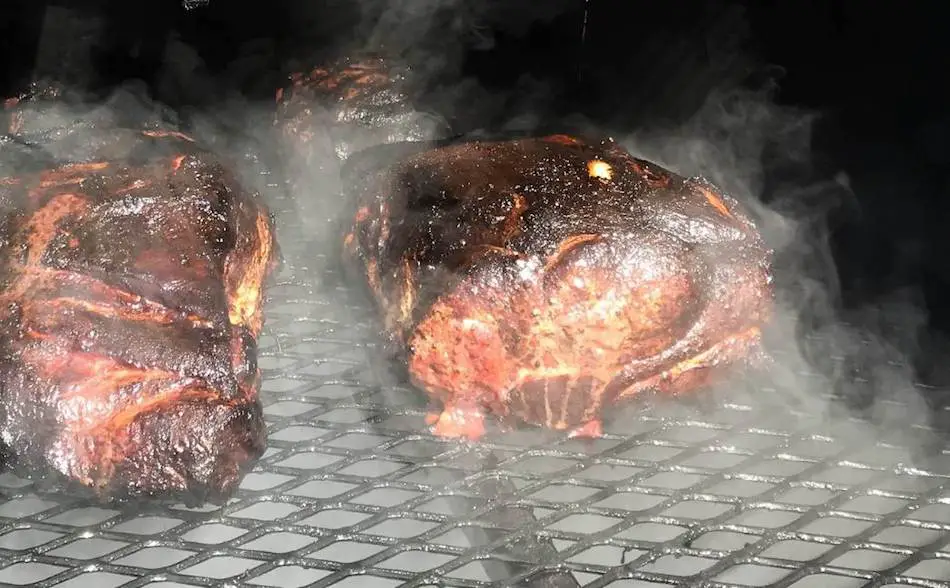
The Last Check
Franklin wraps the pork butt close to 5 hours in, then checks for tenderness at around 8 hours. He twists the bone to see if it’s tender. If the bone pulls out easily, then the pork has reached fall-off-the-bone tenderness. The bone should come clean off, with no meat. It should almost feel you could twist the bone off completely. If the meat is still attached to the bone, then it’s not quite done.
Resting
Franklin will rest the pork butt for about 30 to 45 minutes. Once you’ve removed the meat from the smoker, it’s going to continue cooking while resting. The muscles will still be tight and pushing out moisture. Resting will allow the muscles to relax. This is very important if you want juicy pulled pork. The meat needs time to reabsorb moisture.
Holding
If you’re not ready to serve your pulled pork, place it into holding. Keep the meat wrapped in foil, and wrap again in a dishcloth. Place the pork into a dry cooler and leave it there for 4 to 5 hours.
When To Shred?
Shred the pork when it’s warm enough to pull apart with your fingers. After about 30 or 40 minutes of resting, it should be at a safe temperature to handle. If not, use heat proof gloves, two forks or Bear Claws. Franklin shreds pulled pork in an aluminium pan. Sometimes he puts vinegar or sweet sauce into the pan. Aaron shreds the meat with tongs and his fingers in the aluminium pan.
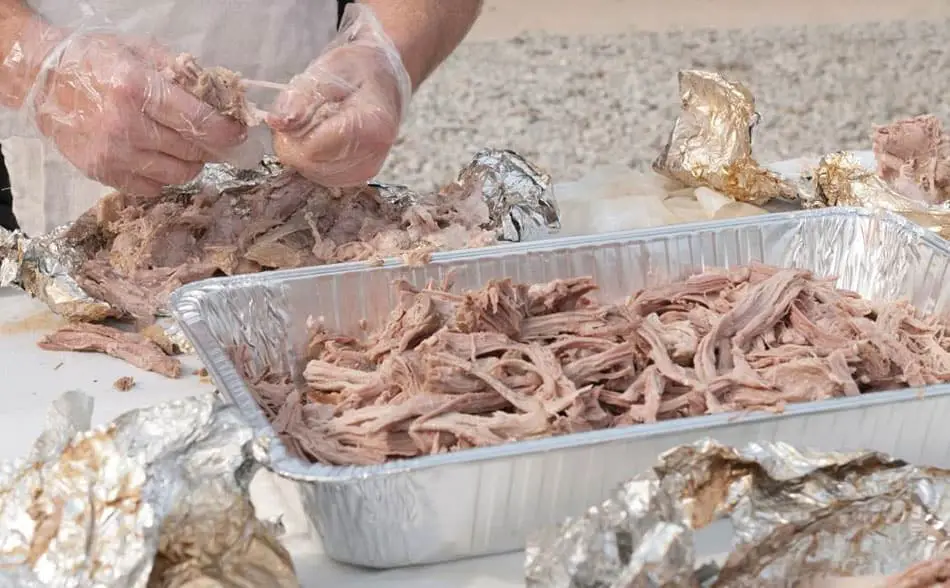
What Type Of Smoker Does Aaron Franklin Use?
Aaron Franklin smoked all his meat on offset smokers (stickburners). Offset smokers have a firebox to the side, and then a separate cooking chamber. This allows for the perfect indirect cooking. In low-and-slow cooking, we cook with indirect heat. Stick burners are fueled by a wood chunks, not necessarily by a charcoal. An offset smoker uses wood chunks as the primary source of heat and smoke. Other types of smokers like kamados, kettles, WSMs use charcoal as the primary fuel source. Wood is then thrown onto the fire for smoke and flavor.
You don’t need an offset smoker to barbecue like Franklin. You can get great results using a kettle grill, pellet smoker, bullet smoker, electric or gas smoker. Offset smokers are difficult to manage, and not recommended for the beginner. You don’t just buy a stickburner. You work your way up to one. And never. Buy one of those cheap offset smokers that they sell in hardware stores. They might look like a stick burner, but they’re not. Real offset smokers are expensive because they are made with thick metal. Cheap offsets have thin metal, so they’re not well insulated. This makes them difficult to control. You don’t need to spend a lot of money on an offset smoker to be like Franklin. You could use his barbecue techniques on a $100 used Weber Kettle.
Pork Butt Time Planner
My Favorite Meat Smoking Tools
Thanks for checking out this article. I hope you learned a few things. Here are some of my favorite tools I use when smoking brisket that may be useful to you. These are affiliate links, so if you decide to purchase any of these products, I’ll earn a commission. But in all honesty, these are the tools I recommend to my family and friends who are just starting out.
Meat Thermometer: There are dozens of fancy thermometers on the market, but I still use my trusty TP20. For around $50, I have a high-quality meat thermometer with two probes, and can track the temperature of my smoker with one probe, and my meat with the other probe. The ThermoPro TP20 is an Amazon Best Seller because it’s the easiest thermometer to operate, is durable, highly accurate, and comes with pre-programmed meat settings.
Instant Read Thermometer: Arguably, the second most important tool you need is a fast and accurate instant-read thermometer. These tools play an important role in the latter stages of the cook when the meat needs regular checking in multiple areas. I use the ThermoPro TP19 because it can do everything a ThermaPen can do, but for a fraction of the cost. You can check out the TP19 on Amazon here.
Wireless Thermometer: The latest thermometers on the market have no wires and can be controlled by wi-fi via your phone. Airprobe 3 is the best of this technology.
Butcher Paper: Wrapping brisket in butcher paper has become a huge trend in barbeque thanks to Aaron Franklin. Wrapping your brisket in paper will give you a nice brisket bark. However, you can’t just use any old paper, it has to be unwaxed, food grade paper. You can find it on Amazon here.
Advanced Thermometer and Automatic Temperature Controller: Once you’re ready to take things seriously, the FireBoard 2 Drive is a six-channel Bluetooth/Wi-Fi thermometer that can monitor up to 6 pieces of meat, control and graph your cook sessions on your smartphone, and attaches to an an automatic blower that will convert your charcoal smoker to a set-and-forget. This is one of the most advanced meat thermometers on the market. You can check it out on the FireBoard website here.
